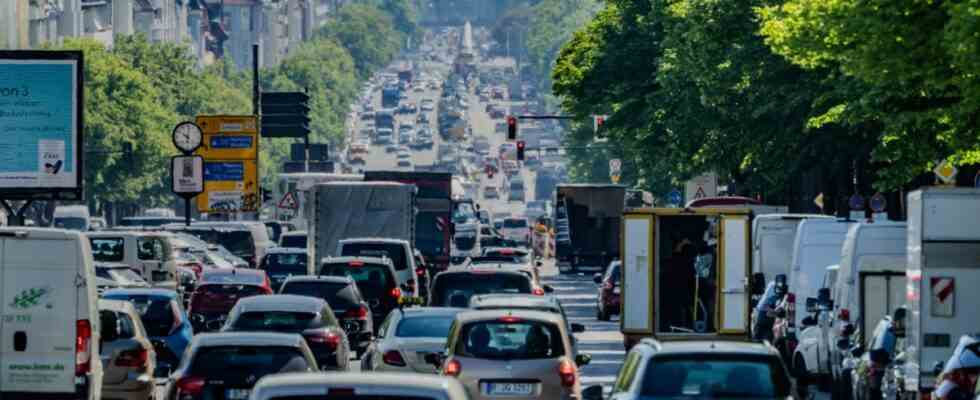It’s about the future of road traffic in Europe, protecting the climate and half a million jobs: The EU wants to tighten the limits on how many greenhouse gases new cars are allowed to emit, and the crucial phase of this explosive project is now beginning. On Wednesday, the competent environment committee of the European Parliament voted on its position on the Commission’s draft law; Negotiations on the legal act between Parliament and the Council of Ministers, the legislative chamber of the member states, could begin as early as this summer.
The draft regulation the Commission is de facto prescribing the end of the internal combustion engine in 2035. For the sake of the climate, manufacturers should only bring electric vehicles onto the market. European industry association Clepa appreciatesthat this will cost half a million jobs in the EU, mainly in suppliers. At the same time, 230,000 new jobs would be created in the production of electric drives and batteries, which together means a loss of 275,000 jobs by 2040, as the lobbyists calculate.
The Christian Democrats and Conservatives in the European Parliament therefore want to tone down the proposal a little and do without a complete ban on combustion engines. This should make the switch easier for companies and employees; In addition, it is risky to rely solely on electric drives, says Jens Gieseke, the transport policy spokesman for the CDU/CSU in the European Parliament: “We don’t even know today whether we can sustainably cover the necessary electricity requirements by 2035 and provide the charging infrastructure.”
But the Environment Committee rejected such amendments on Wednesday with a narrow majority. A similarly narrow majority rejected attempts by the Liberals, Greens and Social Democrats to tighten the Commission’s draft. In the end one was right Majority of 46 to 40 votes for a position not very different from the Commission’s original proposal.
Berlin supports the hard line
The Dutch Liberal Jan Huitema was responsible for the negotiations among the MPs. After the votes, the MEP said the law would create clarity for the auto industry and promote innovation and investment. Buying and driving climate-friendly cars will “become cheaper for consumers: this is particularly important now that diesel and gasoline prices continue to rise”.
The controversial law sets maximum values for carbon dioxide emissions for cars and light commercial vehicles. New cars from a manufacturer are currently not allowed to emit more than 95 grams of the greenhouse gas per kilometer into the atmosphere, otherwise there will be penalties. According to the current legal situation, the limit is to be reduced by 2030. However, the Commission’s proposed regulation will enforce tougher savings: 55 percent less by 2030 and 100 percent less in 2035.
In 13 years, cars will no longer be allowed to emit any CO₂ – de facto the end of the combustion engine. This should help to achieve the ambitious climate protection goals. The EU environmental group Transport & Environment in Brussels praises the ban on internal combustion engines, but would have preferred stricter intermediate goals on the way there. The German manufacturers’ association VDA, on the other hand, warns of new interim targets and also believes it is too early to set the mark for 2035.
The CDU MEP Gieseke applied on Wednesday in the environment committee, but unsuccessfully, to lower the savings target for 2035 from 100 to 90 percent. The corporations should then continue to sell a few combustion cars, even if the majority of the fleet has to be electrically operated. Another failed proposal for a change was to promote so-called e-fuels as an alternative to the electric motor. These are synthetic fuels that chemical plants produce from hydrogen and CO₂, with high power consumption. Combustion engines can use them. Gieseke wanted to implement a system in which car companies support suppliers of these climate-neutral fuels and, as a reward, have to reduce the CO₂ emissions of their fleets less.
Although these ideas fell through in the lead environment committee, there had previously been majorities in the advisory transport committee of the European Parliament. And the industry committee at least supported the push to weaken the target for 2035. In June, the plenary session in Strasbourg will finally vote on the position of the MEPs. Gieseke has already announced that he will submit his amendments there again. Then it will be seen whether environmental, transport or industrial politicians will have the upper hand.
The Council of Ministers could also agree on its negotiating position as early as June. After that, the search for compromise between this body of 27 member states and the European Parliament begins. The Council of Ministers will probably want to keep the combustion engine end planned by the Commission for 2035 – bad for Gieseke. And the Christian Democrat need not hope for the support of the federal government red-green-yellow coalition agreement supports the Brussels goals.

